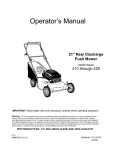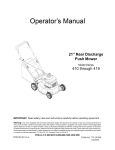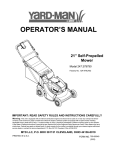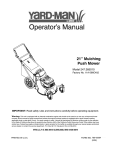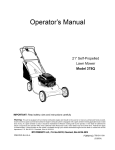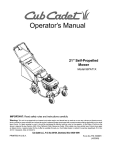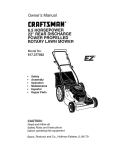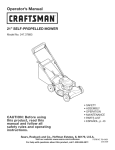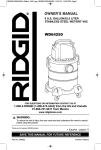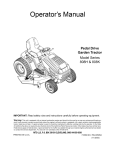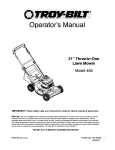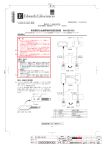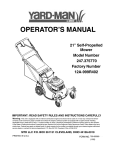Download Cub Cadet 1220 Operator`s manual
Transcript
Operator's Manual 21-inch, 6-Speed Lawn Mower Model SC 621 IMPORTANT: Read safety rules and instructions carefully before operating equipment. Warning: This unit is equipped with an internal combustion engine and should not be used on or near any unimproved forestcovered, brush-covered or grass-covered land unless the engine's exhaust system is equipped with a spark attester meeting applicable local or state laws (if any). If a spark arrester is used, it should be maintained in effective working order by the operator. In the State of California the above is required by law (Section 4442 of the California Public Resources Code). Other states may have similar laws. Federal laws apply on federal lands. A spark arrester for the muffler is available through your nearest engine authorized service dealer or contact the service department, P.O. Box 368023 Cleveland, Ohio 44136-9722. CUB CADET CORP. P.O. BOX 368023 CLEVELAND, OHIO 44136-9722 ECO # 3520 PRINTED IN U.S.A. FORM NO. 770-10090B (11/2000) TABLEOFCONTENTS Content Page Important Safe Operation Practices ................................................................... 3 Slope Gauge ...................................................................................................... 6 Assembling Your Lawn Mower ........................................................................... 7 Know Your Lawn Mower .................................................................................... 9 Operating Your Lawn Mower ............................................................................. 10 Making Adjustments .......................................................................................... 12 Maintaining Your Lawn Mower ........................................................................... 13 Service ............................................................................................................... 15 Off-Season Storage ........................................................................................... 16 Troubleshooting 17 ................................................................................................. Parts List ............................................................................................................ 18 FINDINGMODELNUMBER This Operator's Manual is an important part of your new Lawn Mower. It wilt help you assemble, prepare and maintain the unit for best performance. Please read and understand what it says. Before you start assembling your new equipment, please locate the model plate on the equipment and copy the information from it in the space provided below. The information on the model plate is very important if you need help from our Customer Support Department or an authorized dealer. You can locate the model number by standing behind the unit in the operating position and looking down at the cutting deck. A sample model plate is explained below. For future reference, please copy the model number and the serial number of the equipment in the space below. (Model Number) (Serial Number) Copy the model number here: Copy the serial number here: dl::_fP._"_( CUB P.O. CADET CORP. BOX 368023 CLEVELAND, OHIO 44136__ CALLINGCUSTOMER SUPPORT If you have difficulty assembling this product or have any questions regarding the controls, operation or maintenance of this unit, please call the Cub Cadet Customer Dealer Referral Line at 1-(800)-528-1009. Please have your unit's model number and serial number ready when you call. See previous section to locate this information. By having the model and serial numbers ready, you help your Cub Cadet dealer give you faster service. SECTION1: IMPORTANT SAFEOPERATION PRACTICES WARNING: This symbol points out important safety instructions which, if not followed, could endanger the personal safety and/or property of yourself and others. Read and follow all instructions in this manual before attempting to operate this machine. Failure to comply with these instructions may result in personal injury. When you see this symbol--HEED ITS WARNING. WARNING: Engine exhaust, some of its constituents, and certain vehicle components contain or emit chemicals known to State of California to cause cancer and birth defects or other reproductive harm. DANGER: This any type of power machine is capable tions could result in machine was built to be operated according to the rules for safe operation in this manual. As with equipment, carelessness or error on the part of the operator can result in serious injury. This of amputating hands and feet and throwing objects. Failure to observe the following safety instrucserious injury or death. GeneralOperation 9. 1. 10. 2. 3. 4. 5. 6. 7. 8. Read this operator's manual carefully in its entirety before attempting to assemble this machine. Read, understand, and follow all instructions on the machine and in the manual(s) before operation. Be completely familiar with the controls and the proper use of this machine before operating it. Keep this manual in a safe place for future and regular reference and for ordering replacement parts. This machine is a precision piece of power equipment, not a plaything. Therefore, exercise extreme caution at all times. Your unit has been designed to perform one job: to mow grass. Do not use it for any other purpose. Never allow children under 14 years old to operate this machine. Children 14 years old and over should read and understand the operation instructions and safety rules in this manual and should be trained and supervised by a parent. Only responsible individuals who are familiar with these safe operation rules should use this machine. Thoroughly inspect the area where the equipment is to be used. Remove all stones, sticks, wire, bones, toys and other foreign objects which could be tripped over or picked up and thrown by the blade. Thrown objects can cause serious personal injury. Plan your mowing pattern to avoid discharge of material toward roads, sidewalks, bystanders and the like. Also, avoid discharging material against a wall or obstruction which may cause discharged material to ricochet back toward the operator. To help avoid blade contact or a thrown object injury, stay in the operator zone behind the handles and keep bystanders, helpers, children and pets at least 75 feet from the machine while it is in operation. Stop machine if anyone enters the area. Always wear safety glasses or safety goggles during operation and while performing an adjustment or repair to protect your eyes. Thrown objects which ricochet can cause serious injury to the eyes. Wear sturdy, rough-soled work shoes and close-fitting slacks and shirts. Shirts and pants that cover the arms and legs and steel-toed shoes are recommended. Never operate this machine in bare feet, sandals, slippery or light weight (e.g. canvas) shoes. Do not put hands or feet near rotating parts or under the cutting deck. Contact with the blade can amputate hands and feet. 11. 12. 13. 14. 15. 16. 17. 18. 19. 20. A missing or damaged discharge cover can cause blade contact or thrown object injuries. Many injuries occur as a result of the mower being pulled over the foot during a fall caused by slipping or tripping. Do not hold on to the mower if you are falling; release the handle immediately. Never pull the mower back toward you while you are walking. If you must back the mower away from a wall or obstruction first look down and behind to avoid tripping and then follow these steps: a. Step back from the mower to fully extend your arms. b. Be sure you are well balanced with sure footing. c. Pull the mower back slowly, no more than half way toward you. d. Repeat these steps as needed. Do not operate the mower while under the influence of alcohol or drugs. Do not engage the self-propelled mechanism on units so equipped while starting engine. The blade control handle is a safety device. Never attempt to bypass its operation. Doing so makes the safety device inoperative and may result in personal injury through contact with the rotating blade. The blade control handle must operate easily in both directions and automatically return to the disengaged position when released. Never operate the mower in wet grass. Always be sure of your footing. A slip and fall can cause serious personal injury. If you feel you are losing your footing, release the blade control handle immediately and the blade will stop rotating within three seconds. Mow in daylight or good artificial light. Walk, never run. Stop the blade when crossing gravel ddves, walkways or roads. If the equipment should start to vibrate abnormally, stop the engine and check immediately for the cause. Vibration is generally a warning of trouble. Shut the engine off and wait until the blade comes to a complete stop before removing the grass catcher or unclogging the chute. The cutting blade continues to rotate for a few seconds after the engine is shut off. Never place any part of the body in the blade area until you are sure the blade has stopped rotating. Never operate mower without proper trail shield, discharge cover, grass catcher, blade control handle or othersafety protective devices inplaceandworking. power mower. Children 14 years old and over should Never operate mower withdamaged safetydevices. read and understand the operation instructions and Failure todoso,canresultinpersonal injury. safety rules in this manual and should be trained and 21. Mufflerandenginebecomehotandcancauseabum. Do supervised by a parent. nottouch. 22. Onlyusepartsandaccessories made forthismachine by Service theodginal equipment manufacturer (O.E.M). Failure to dosocanresultinpersonal injury. Safe Handlingof Gasoline: 23. Ifsituations occurwhich arenotcovered inthismanual, 1. To avoid personal injury or property damage use extreme usecareandgoodjudgment. Contact yourdealer for care in handling gasoline. Gasoline is extremely assistance. Telephone 1-800-528-1009 forthenameof flammable and the vapors are explosive. Serious yournearest dealer. personal injury can occur when gasoline is spilled on SlopeOperation Slopes are a major factor related to slip and fall accidents which can result in severe injury. Operation on slopes requires extra caution. If you feel uneasy on a slope, do not mow it. Before operating this unit on a slope or hilly area, use the slope gauge on page 6 to measure slopes. If the slope is greater than 15 degrees, do not mow it. Do: 1. 2. 3. Mow across the face of slopes; never up and down. Exercise extreme caution when changing direction on slopes. Watch for holes, ruts, rocks, hidden objects, or bumps which can cause you to slip or trip. Tall grass can hide obstacles. Always be sure of your footing. A slip and fall can cause serious personal injury. If you feel you are losing your balance, release the blade control handle immediately, and the blade will stop rotating within 3 seconds. Do Not: 1. 2. 3. Do not mow near drop-offs, ditches or embankments, you could lose your footing or balance. Do not mow slopes greater than 15 degrees as shown on the slope gauge. Do not mow on wet grass. Unstable footing could cause slipping. yourself or your clothes which can ignite. Wash your skin and change clothes immediately. Use only an approved gasoline container. Never fill containers inside a vehicle or on a truck or trailer bed with a plastic liner. Always place containers on the ground away from your vehicle before filling. 5. If possible, remove gas-powered equipment from the truck or trailer and refuel it on the ground. If this is not possible, then refuel such equipment on a trailer with a portable container, rather than from a gasoline dispenser nozzle. 6. Keep the nozzle in contact with the rim of the fuel tank or container opening at all times until fueling is complete. Do not use a nozzle lock-open device. 7. Extinguish all cigarettes, cigars, pipes and other sources of ignition. 8. Never fuel machine indoors because flammable vapors will accumulate in the area. 9. Never remove gas cap or add fuel while the engine is hot or running. Allow engine to cool at least two minutes before refueling. 10. Never over fill fuel tank. Fill tank to no more than V_inch 2. 3. 4. below bottom of filler neck to provide space for fuel expansion. 11. Replace gasoline cap and tighten securely. 12. If gasoline is spilled, wipe it off the engine and equipment. Move unit to another area. Wait 5 minutes before starting the engine. 13. Never store the machine or fuel container inside where Tragic accidents can occur if the operator is not alert to the presence of children. Children are often attracted to the mower and the mowing activity. They do not understand the dangers. Never assume that children will remain where you last saw them. there is an open flame, spark or pilot light as on a water heater, space heater, furnace, clothes dryer or other gas appliances. 14. To reduce fire hazard, keep mower free of grass, leaves, or other debris build-up. Clean up oil or fuel spillage and remove any fuel soaked debris. 15. Allow a mower to cool at least 5 minutes before stodng. 1. GeneralService: Children 2. 3. 4. 5. 6. Keep children out of the mowing area and under the watchful care of a responsible adult other than the operator. Be alert and turn mower off if a child enters the area. Before and while moving backwards, look behind and down for small children. Use extreme care when approaching blind corners, doorways, shrubs, trees, or other objects that may obscure your vision of a child who may run into the mower. Keep children away from hot or running engines. They can suffer burns from a hot muffler. Never allow children under 14 years old to operate a 1. 2. 3. Never run an engine indoors or in a poorly ventilated area. Engine exhaust contains carbon monoxide, an odorless and deadly gas. Before cleaning, repairing, or inspecting, make certain the blade and all moving parts have stopped. Disconnect the spark plug wire and ground against the engine to prevent unintended starting. Check the blade and engine mounting bolts at frequent intervals for proper tightness. Also, visually inspect blade for damage (e.g., bent, cracked, worn) Replace blade with the original equipment manufacture's (O.E.M.) blade only, listed in this manual. "Use of parts which do not meettheoriginal equipment specifications mayleadto improper performance andcompromise safety!" 4. Mowerblades aresharpandcancut.Wrapthebladeor weargloves, anduseextra caution when servicing them. 5. 6. 7. 8. 9. Keep all nuts, bolts, and screws tight to be sure the equipment is in safe working condition. Never tamper with safety devices. Check their proper operation regularly. After striking a foreign object, stop the engine, disconnect the spark plug wire and ground against the engine. Thoroughly inspect the mower for any damage. Repair the damage before starting and operating the mower. Never attempt to make a wheel or cutting height adjustment while the engine is running. Grass catcher components, discharge cover, and trail shield are subject to wear and damage which could expose moving parts or allow objects to be thrown. For safety protection, frequently check components and replace immediately with original equipment manufacturer's (O.E.M.) parts only, listed in this manual. "Use of parts which do not meet the original equipment specifications may lead to improper performance and compromise safety!" 10. Do not change the engine governor setting or overspeed the engine. The governor controls the maximum safe operating speed of the engine. 11. Maintain or replace safety and instruction labels, as necessary. 12. Observe proper disposal laws and regulations. Improper disposal of fluids and materials can harm the environment. YourResponsibility • Restrict the use of this power machine to persons who read, understand this manual and on the machine. and follow the warnings and instructions WARNING in USE THIS PAGE AS A GUIDE TO DETERMINE SLOPES WHERE YOU MAY NOT OPERATE SAFELY. ¢# SIGHT AND HOLD THIS LEVEL WITH A VERTICAL TREE A POWER POLE A CORNER OF A BUILDING OR A FENCE POST 5" I I O) ¢# o) ¢0 t I O3 ,.< O C 3 ¢0 o O ¢0 8. ¢# 3 o) ¢0 WARNING ,_ .'F Do not mow on inclines with a slope in excess of 15 degrees (a rise of approximately 2-1/2 feet every 10 feet). A riding mower could overturn and cause serious injury. If operating a walk-behind mower on such a slope, it is extremely difficult to maintain your footing and you could slip, resulting in serious injury. Operate RIDING mowers up and down slopes, never across the face of slopes. Operate WALK-BEHIND mowers across the face of slopes, never up and down slopes. m SECTION3: ASSEMBLING YOURLAWNMOWER Unpacking AssemblingHandle • • • • • Remove staples, break glue on top flaps, or cut tape at carton end and peel along top flap to open. Remove loose parts if included with unit (i.e., operator's manual, hardware pack etc.). Cut corners and lay carton down flat. Remove packing material. Roll or slide unit out of carton. Check for loose parts thoroughly before discarding carton. • • For shipping purposes, the grass bag was packed on top of the unit. Remove the grass bag and set it out of the way. Pull the upper handle upwards in the direction shown in Figure 3. Align it with the lower handle. Tighten wing nut securing the upper handle with the lower handle on each side. Upper Handle HardwarePack Please identify each piece of the hardware pack as shown in Figure 1. _Wing Nut 1/4-20 (2) e Bolt 1/4-20 (2) Lower Handle Figure 1 ToolsRequired 1. 2. Pair of Pliers Funnel Bolt NOTE: Reference to right or left hand side of the mower is from the operating position. IMPORTANT: This unit is shipped WITHOUT GASOLINE OR OIL in the engine. Be certain to service engine with fresh gasoline and oil as instructed in the engine manual, the engine manual is packed seperatety in the carton. Nut Figure 3 Raise complete handle assembly, as shown in Figure 4, until it clicks into place. Make sure not to kink the control cables. Handle Assembly Disconnect SparkPlugWire • Disconnect the spark plug wire from the spark plug, and ground it against the engine by attaching rubber boot to a bolt. See Figure 2. Spark Wire Spark Plug Figure 4 Figure 2 Pinch lower handle against the handle mounting bracket with a pair of pliers. Move hairpin clip from the outer to the inner hole of the weld pin on the handle mounting bracket on each side. See Figure 5. Cable Tie \ Lowe Handle Lowe_ Handl pin Clip Handle Mountin Bracket Figure 7 Figure 5 After you have moved the hairpin clips, place one carriage bolt (included in the hardware pack) in the upper hole of the right handle mounting bracket from the inside outward. See Figure 6. Secure with one plastic wing nut. Repeat process on the left. NOTE: Make sure the drive cable is routed around the outside and above the lower handle so as not to interfere with the grass bag attachment. The rope guide, which is connected to the support rod, is located on the right side of the lower handle. See Figure 8. With the spark plug wire disconnected and grounded, hold the blade control handle against the upper handle, and pull the starter rope out of the engine. Release the blade control handle. Slip the starter rope into the rope guide. See Figure 8. Starter Rope _Support Rod Guide Figure 6 Attach control cables to handle by inserting post of cable ties into the holes on the lower handle. The holes may be on either side of the handle. Pull cable ties tight and cut off the extra. See Figure 7. Figure 8 SECTION4: KNOWYOURLAWNMOWER Compare the illustrations in Figure 9 with your lawn mower to acquaint yourself with the location and working of various controls and adjustments on the equipment. Always wear safety glasses while performing any adjustments on the mower. Blade Control Cuffing Height _stment Lever Front Wheel Drive Clutch Control Front Wheel Height Adjuster Figure 9 Blade ControlHandle • The blade control handle is located on the upper handle of the mower. • • Depress the blade control handle in order to start and operate the unit. Release the blade control handle to stop the engine and the blade. WARNING: negotiating an obstacle, making a turn or stopping. Shift Lever The shift lever is the shorter of the two levers located in the drive clutch control housing on the upper handle. • The blade control handle is a safety device. Never attempt to bypass its operations. The blade will be rotating whenever the engine is running. Release the drive clutch control to stow down when Use this lever to select any of the six forward speeds available on this mower model. Note that when sliding the lever up or down to change speed selection, you will have to release the drive clutch control lever. Throttle Control/ChokeLever NOTE: Move the shift lever only when the engine is running. Changing the shift lever setting with the engine off can cause damage to the mower's drive system. The engine is equipped with a constant speed throttle, which is already set at full throttle for best performance. CasterLock Recoil Starter hills, front wheels should be locked in the WARNING: When operating mower on straight ahead position. The recoil starter handle is attached to the lower handle. _, • The casters can be locked in a straight ahead position or can be left to swivel freely. Stand behind the unit in the operating position to start the unit. Drive ClutchControl • The drive clutch control lever is the longer of the two levers located in a seperate housing attached to the top of the upper handle. • • EngineControls Squeeze the drive clutch control to engage the drive system; release the clutch control to disengage. Lift and place the lock pins in the larger holes to lock the wheels for straight-ahead operation. Place pins in smaller holes to allow casters to rotate freely for turning. Refer to the engine manual for location and function of the controls located on the engine. SECTION5: OPERATING YOURLAWNMOWER rewind slowly. Pull rope with a rapid, continuous, full arm stroke. Keeping a firm grip on the starter handle, let the rope rewind slowly. GasandOilFill-Up • Service the engine with gasoline and oil as instructed in the accompanying engine manual. Follow all instructions carefully. WARNING: StoppingEngineandBlade Never fill fuel tank indoors, • with engine running or until the engine has been allowed to cool for at least two minutes Release the blade control handle to stop the engine and blade. after running. for a few seconds the continues engine is shut off. WARNING: Theafter blade to rotate ,_ BeforeStarting • • NeutralAdjustmentTest Attach spark plug wire to spark plug. Make certain the metal cap on the end of the spark plug wire (inside the rubber boot) is fastened securely over the metal tip on the spark plug. Check the drive clutch control for proper adjustment. If the mower does not propel itself or the drive wheels hesitate with the drive clutch • To perform this test, answer the following questions after having started the mower and engaged the drive clutch control: 1. engaged, perform the drive clutch control adjustment as instructed on page 16. 2. 3. StartingEngine • 4_11 operator is standing the other lawn than mower WARNING: Be sure near no one the while starting engine or operating mower. Never run engine indoors or in enclosed, poorly ventilated areas. Engine exhaust contains carbon monoxide, an odorless and deadly gas. IMPORTANT: If you are cutting grass on a slope, always lock the front wheel casters of your mower for straight ahead operation. On level ground you may leave the casters unlocked to pivot freely. When starting the unit for the first time, face the mower against a solid object such as a wall, fence, etc. Start the unit and if it shows any signs of motion while the drive clutch control is still disengaged, shut the engine off immediately. • • • sharp bends? If you answered "yes' to all three questions, your mower passed the test and you can start your mower. If you answered "no" to any of the three questions, you need to perform the "Drive Clutch Control Adjustment" as instructed on page 13. LockingCasters Keep hands, feet, hair and loose clothing away from any moving parts on engine and lawn mower. • With the engine OFF and the drive clutch control released, push mower forward and pull it backward. Does it move freely? Squeeze drive clutch control and pull the mower backward. Do rear wheels lock up? Is the drive clutch control cable free of kinks or Unlocked Position Locked Make sure that the drive clutch control is adjusted so the drive belt is as loose as possible. Push the primer three times. Wait two seconds between each push. In temperatures below 55 ° F, prime five times. Do not prime to restart a warm engine after a short shutdown. Standing behind the mower, depress the blade control handle and hold it against the upper handle. Grasp starter handle and pull rope out slowly until engine reaches start of compression cycle (rope will pull slightly harder at this point). Let the rope Figure 10 • • 10 To turn the mower on a slope with casters locked, depress the upper handle and raise the front wheels slightly. To lock caster: Lift and place the lock pin in the larger hole on each caster. See Figure 10. • To unlock caster: Lift and place the lock pin in the smaller hole to allow casters to rotate freely. See Figure 10. Chute Door Lift bag here Lower Handle of / Grass Bag / casters unlocked since the mower can drift WARNING: Do not mow on slopes with downhill. BaggingGrassClippings This mower can bag grass clippings. For that, you will have to install the grass bag on to the unit. • Remove the three wing nuts holding the mulching baffle or side discharge chute in place. Then remove the plug or the chute as the case may be. See Figure 11. Figure 13 EmptyingYour GrassBag • Lift grass bag from the bagging adapter using the lower handle of the grass bag. While holding the lower handle, lift up the rear section of the grass bag. See Figure 13. The bag will open and grass clippings will fall out. Empty the grass bag at a proper disposal site. Nut Remove mulching baffle J Side-Discharge GrassClippings •_ -_---_ Wing Nut This mower can also side-discharge grass clippings. For that, you will have to install the side-discharge chute on to the unit. Figure 11 Replace with bagging adapter. Attach using three wing nuts removed earlier. Be sure that inner lip of attachment goes under the edge of the deck. See Figure 12. • • Bagging Adapte_ \ Remove mulching baffle or grass bag adapter. See Figure 11. Attach discharge chute with wing nuts. See Figure 14. Once the side-discharge chute is in place, you can run the mower and the grass clippings will be discharged sideways. <_= Side-Discharge Chute Figure 14 Figure 12 MulchingGrass Lift chute door and slide bag onto adapter. Top of bag rests on wire bracket that extends between the handles. See Figure 13. • 11 When the mulching baffle is installed on the unit, the mower is used to mulch grass clippings. If the mulching baffle is not already installed, you will have to remove the grass bag or side-discharge chute as the case may be, and install the mulching baffle for the purpose. Make sure wing nuts securing the mulching baffle to the deck (Figure 11 ) are firmly tightened before starting to mulch. UsingYourRotaryMower • WARNING: If your mower strikes a foreign object, stop the engine. Remove wire from spark plug, thoroughly inspect for any damage, and do necessary repairs before operating the mower again. Extensive vibration of the mower during operation is an indication of damage. Make sure that lawn is clear of stones, sticks, wire, or other objects which could damage the lawn mower or its engine.. For best results, do not cut wet grass. New grass, thick grass or wet grass may require a narrower cut. For a healthier lawn, never cut off more than onethird of the total length of the grass. • • SECTION6: MAKINGADJUSTMENTS assembly and secure with the wing nut previously removed. See Figure 15B. WARNING: Do not at any time make any adjustment to lawn mower without first stopping engine and disconnecting spark plug wire. IMPORTANT: All wheels must be placed in the same relative position. For rough or uneven lawns, raise the cutting height of your lawn mower. CuttingHeight HandleHeight The rear wheel cutting height adjustment lever is located above the left rear wheel. • Your mower is shipped with the handle in the higher height position.To lower the handle height for your convenience, proceed as follows. To adjust, pull the lever out and away from the mower and move it forward or backward to the desired cutting height. See Figure 15A. The front wheel cutting height is determined by the selection of one of six slots in each caster assembly. [] Handle Adjustment Lever Figure 16 • • [] • • Axle Bolt \ _$J_.'_\ _ Notch Nut • • Figure 15 To adjust, remove the wing nut from the axle bolt. Slide the axle bolt and spring washer from the assembly and select a cutting height. With the spring washer on the axle bolt, reinsert hardware in the square hole desired through the wheel • • 12 Remove the starter rope from the rope guide. Remove the upper handle by removing the hand knobs and carriage bolts. Lay the upper handle out of the way, being careful not to bend or kink cables. Remove the hairpin clips from the weld pins on the handle brackets. Remove carriage bolts and wing nuts from the two handle brackets on both sides. Press outward on the legs of the lower handle, and remove it from the mower. Turn the lower handle around so the notches on the bottom of the lower handle are facing forward as shown in Figure 16. Reassemble, placing the bottom holes in the handle over the weld pins in the handle mounting bracket. Reassemble the upper handle. Place the hairpin clips in the inner holes in the weld pins. Secure carriage bolts and wing nuts on the handle brackets. Reattach the starter rope. DriveClutchControl of the mower beside the engine. Follow steps below to adjust the shift lever. The drive clutch control adjustment wheel is located in the drive clutch control handle housing and is used to tighten or loosen the drive belt. You will have to adjust the drive clutch control if any of the following happens: 1. 2. • • • The mower does not propel itself with the drive clutch engaged. The mower's drive wheels hesitate with the drive • clutch engaged. To resolve the above problems, rotate the adjustment wheel with your fingers: clockwise to tighten the cable and counter-clockwise to loosen the cable. See Figure 17. Start the engine and place speed control lever in the sixth speed position. Stop the engine; disconnect spark plug wire and ground it. Loosen hex nut (A) which secures the adjustable cable bracket. This bracket is located on the left side (towards the center) of the cutting deck. See Figure 18 for location of the bracket. Bottom View Adjust_en _ Wheel \\ _ ___ Hex Nut Adj, Figure 17 NOTE: For some operators, the drive clutch handle may not be in a comfortable position. If so, you can adjust the handle by tightening the adjustment wheel ShiftLeverCable Figure 18 Periodic adjustment of the six-speed shift cable may be required due to normal wear on the cable. Adjustment is needed if all six speeds do not work. • • Push back on the adjustable cable bracket. See Figure 18 inset. After adjusting as required, tighten hex nut (A). The adjustable cable bracket is located on the left side SECTION7: MAINTAININGYOURLAWNMOWER accumulate, it wilt invite rust and corrosion, and prevent proper mulching, discharge or bagging. To clean, tilt the mower and scrape clean with a suitable tool. disconnect spark stop plug wire WARNING: the Always engine before and cleaning, lubricating or doing any kind of maintenance work on the lawn mower. NOTE: We do not recommend the use of pressure washers or garden hose to clean your unit. These may cause damage to electric components, spindles, pulleys, bearing or the engine. The use of water will result in shortened life and reduced serviceability. IMPORTANT: When tipping the unit, empty the fuel tank and keep the engine with the discharge chute side up. Never tip the mower more than 90 degrees and do not leave the mower tipped for any length of time. Oil can drain into the upper part of the engine or air filter element causing a starting problem. CuttingBlade CuttingDeck • • Clean the underside of the mower deck after each use to prevent buildup of grass clippings, leaves, dirt or other matter. If this debris is allowed to 13 Periodically inspect the blade adapter for cracks, especially if you strike a foreign object. Replace when necessary. Lubrication WARNING: When removing the cutting blade for sharpening or replacement, protect hands by wearing heavy gloves or using a heavy rag to hold the blade. • • BladeControl • Remove the bolt and the blade bell support which hold the blade and the blade adapter to the engine crankshaft. See Figure 19 Remove the blade and the blade adapter from the crankshaft. See Figure 19. Lubricate the pivot points on the blade control handle and the brake cable at least once a season with light oil. See Figure 20. The blade control must operate freely in both directions. Wheels • Lubricate the wheel at least once a season with light oil (or engine oil). Also, if the wheels are removed for any reason, lubricate the surface of the axle bolt and the inner surface of the wheel with light oil. See Figure 20. Blade Adapter CasterAssembly / • Blade Bell Support Hex Bolt Engine • Figure 19 • Grease fittings are provided for easy lubrication of the swivel pins located on the front caster assembly. See Figure 20. Follow engine manual for lubrication instructions. Lubricate Lubricate Lubricate When sharpening the blade, follow the original angle of grind as a guide. Lubricate NOTE: It is extremely important that each cuffing edge receives an equal amount of grinding to prevent an unbalanced blade. Such unbalanced blade will cause excessive vibration when rotating at high speeds. It may damage the mower, and/or cause personal injury. • • • • • Test the blade by balancing it on a round shaft screwdriver. Remove metal from the heavy side until it balances evenly. It is recommended that the blade always be removed from the adapter when testing for balance. Before reinstalling the blade and the blade adapter to the unit, lubricate the engine crankshaft and the inner surface of the blade adapter with light oil. Be sure to install the blade with the side of the Refer to Engine Manual Figure 20 EngineMaintenance Refer to the separate engine manual for all engine maintenance instructions. • blade marked "Bottom" (or with part number) facing the ground when the mower is in the operating position. See Figure 19. Slide blade adapter toward the engine crankshaft Place blade on adapter. Be certain the blade is aligned with and seated on the blade adapter flanges. Place blade bell support on blade. Make sure the notches on the blade bell support are aligned with the small hole in the blade. • • • Replace hex bolt and tighten to secure. Torque: 450 in. Ibs. min., 600 in. lbs. max. • NOTE: To ensure safe operations of your unit, periodically check the blade bolt for correct torque. 14 Maintain engine oil as instructed in the engine manual. Follow all instructions carefully. Service air cleaner every 25 hours under normal conditions. Clean every few hours under extremely dusty conditions. Poor engine performance and flooding usually indicates that the air cleaner should be serviced. To service the air cleaner, refer to the engine manual. The spark plug should be cleaned and the gap reset once a season. Spark plug replacement is recommended at the start of each mowing season. Check engine manual for correct plug type and gap specifications. Clean engine regularly with a cloth or brush. Keep the cooling system (blower housing area) clean to permit proper air circulation which is essential to engine performance and life. Remove all grass, dirt and combustible debris from muffler area. SECTION8: SERVICING YOURMOWER ReplacingDriveBelt • • • • • • Disconnect the spark plug wire and ground it against the engine. Drain the fuel tank or place a piece of plastic beneath the cap to prevent gasoline leakage. Place shift lever in the first position and tip the mower on its side. Remove the center bolt which secures the blade to Transmission __ Pulley Belt_ Belt Keepe Bracket-Idler Pulley --''''_ Bracket Idler_ Pulle_ the crankshaft followed by blade bell support, blade, and blade adapter. Move the cutting height adjustment to the highest position. Remove the three hex screws holding the baffle to the deck and pivot baffle towards the rear of the mower. See Figure 21. Transmission Bolt and/ Locknut Figure 23 Baffle Slide the belt out from between the belt keeper bracket and the idler pulley. See Figure 23. Figure 21 Remove the hex bolt from the rear of unit holding the transmission to the mower housing. See Figure 22. Six-Speed Cable Slot Belt Control Arm Cutting Height Adjustment Figure 24 NOTE: Mower is flipped on itsleft wheels for better access. • Figure 22 • Tilt the transmission forward and loosen the idler • pulley bolt and lock nut half a turn. See Figure 23. Using a pair of pliers, pull back and rotate belt keeper bracket from the slot on the idler pulley. • • 15 Squeeze the belt together and push it forward, while pressing the control arm inward towards the deck. Remove the six-speed cable from the slot. See Figure 24. Pivot the control arm down and away from the pulley and the belt. See Figure 24. Lift off the lower pulley assembly and remove the old belt from around the crankshaft. See Figure 25. Lower Pulley F o Lower Pulley Half'x / "_ _ o o o Belt ,_ Figure 27 Figure 25 • • • • • • Place the new belt over the transmission pulley. Start the belt in the pulley groove and rotate the pulley until the belt is seated in transmission pulley. Place the belt between the idler pulley and the belt keeper bracket. Using a pair of pliers, rotate the belt keeper bracket so that it snaps into slot on the idler bracket. Tighten the idler pulley bolt and lock nut half a turn. Place the belt between the two pulley halves on the crankshaft. Make sure to route the belt inside the belt guard pin. See Figure 26. o Belt ard Pin • Pivot the control arm back to its original position and reinstall the six-speed cable into the slot. See Figure 28. Check and make sure the belt is routed inside the pulley halves and the belt guard pin. Six-Speed Cable Slot o Control _ Arm Figure 28 Reinstall the bolt securing transmission to rear mower housing. Pivot the baffle back to its original position and secure with three hex screws earlier removed. Lightly lubricate the inside of the blade adapter and reinstall the spacer, wave washer, blade adapter assembly, and blade in the correct order. Tighten the hex bolt to secure the blade to torque: 450-600 in. Ibs. Pulley Half Figure 26 IMPORTANT: When replacing the belt, do not disassemble the lower pulley assembly. • Pinch both sides of the belt together so that the belt is not in the pulley groove, and the lower pulley can be pushed towards the engine. See Figure 27. SECTION9: OFF-SEASON STORAGE The following steps should be taken to prepare lawn mower for storage. • • • • Clean and lubricate mower thoroughly as described in the lubrication instructions. We do not recommend the use of pressure washers or garden hose to clean your unit. They may cause damage to electric components, spindles, pulleys, bearings or the engine. The use of water will result in shortened life and reduce serviceability. • Refer to engine manual for storage instructions. Coat mower's cutting blade with chassis grease to prevent rusting. Store mower in a dry, clean area. Do not store next to corrosive materials, such as fertilizer. NOTE: When storing any type of power equipment an unventilated or metal storage shed, care should taken to rust-proof the equipment. Using a light oil silicone, coat the equipment, especially cables and moving parts. 16 in be or all SECTION10: TROUBLE SHOOTING GUIDE Trouble Possible Cause(s) 1. Blade control handle disengaged. 2. Spark plug wire disconnected. 3. Engine not primed. 4. Fuel tank empty, or stale fuel. 5. Blocked fuel line. 6. Faulty spark plug. 7. Engine flooded. 1. Spark plug wire loose. 2. Blocked fuel line or stale fuel. Corrective Action 3. 4. 5. 6. Vent in gas cap plugged. Water or dirt in fuel system. Dirty air cleaner. Carburetor out of adjustment. 3. 4. 5. 6. Engine overheats 1. 2. 3. 1. 2. 3. Occasional skip (hesitates) at high speed Idles poorly 1. Engine oil level low. Air flow restricted. Carburetor not adjusted properly. Spark plug gap too close. Engage blade control handle. Connect wire to spark plug. Depress primer bulb slowly three times. Fill tank with clean, fresh gasoline. Clean fuel line. Clean, adjust gap or replace. Wait for the engine to dry out. Tighten spark plug wire. Clean fuel line; fill tank with fresh gasoline. Clear vent. Drain fuel tank. Refill with fresh fuel. Clean air cleaner. Adjust carburetor. Follow engine manual. Fill crankcase with proper oil. Remove blower housing and clean. Adjust carburetor. 1. Adjust gap to .030". Spark plug fouled, faulty or gap too wide. Carburetor out of adjustment. 1. Reset gap to .030" or replace spark plug. Adjust carburetor. Follow engine manual. Clean air cleaner. Tighten blade and adapter. Balance blade. Replace blade. Wait until later to cut. Mow once at a high cutting height, then mow again at desired height or make a narrower cutting swath (1/2 width). Sharpen or replace blade. Placeallfourwheetsinsame height position. Sharpen or replace blade. Engine fails to start Engine runs erratic 1. 2. Excessive vibration 3. 1. 2. Mower wilt not mulch grass 1. 2. Uneven cut 3. 1. 2. 1. 2. 3. 4. 5. 6. 7. 1. 2. 2. Dirty air cleaner. Cutting blade loose or unbalanced, Bent cutting blade. Wet grass. Excessively high grass. 3. 1. Dull blade. Wheels not positioned correctly, Dull blade. 3. 1. 2. 1. 2. 2. Refer to separate engine manual packed with your mower for more engine related information. NOTE: For repairs beyond the minor adjustments listed above, contact your nearest Cub Cadet dealer. 17 SECTION11: PARTSLISTFORMODELSC621 Transmission Assembly 64 J 14 / 38 "_30 33 15 26 7 Pulley Assembly Reference only •75 6O 51 \ 58 55 59 56 \ 39 16 37 25 61 48 87 86 g 84 8 lO 83 /_ 70 68 18 NOTE: For painted parts, please refer to the list of color codes below. Please add the applicable color code wherever needed, to the pan number to order a replacement part. For instance if a part numbered 70O-xxxx is painted Cub Yellow. the part number to order would be 70Oxxxx-0716. Cub Yellow: 0716 Powder Black: 0637 ModelSC621 Ref. No. I 2 3 4 5 6 7 8 9 10 11 12 13 14 15 16 17 18 19 20 21 22 23 24 25 26 27 28 29 30 31 32 33 34 35 36 37 38 39 40 41 42 Part No. 710-0134 710-0654A 710-0703 712-0397 723-0233 736-0204 782-0046B 710-0653 710-1220 731-1828 638-0012 782-0566B 682-7526 682-7528 710-0653 710-0751 710-0896 710-1315 711-0835 713-0453 714-0474 720-0223 732-0803A 732-0832 736-0270 736-0369 738-0529 741-0324 741-0522 741-0978 748-0318 750-0151 750-0515 750-0807 750-1056 782-0568 682-3052 682-3053 710-1348 731-1901 732-0842 682-9020A Description Scr. Carr. 1/4-20 x .62 Scr. TT:3/8-18:1.00 Carriage Scr. 1/4-20 x .750 Wing Nut 1/4-20 Nut, Push .25 I.D. x .50 O.D. Wash. FL .334 I.D.x .62 x.03 Deck - 21" Scr. TT. 1/4-20 x .375 Scr. HL. 1/2-14 x .750 Baffle Rear Axle Assembly Pivot Arm Assembly Trans. Axle Assembly Chain Cover Assembly Scr. TT 1/4-20 x .375 Cap Screw HH 1/4-20 x .620 Scr. AB 1/4--20x.625 Scr. 3/8 116 x .25 Clevis Pin .50 Dia. x 4.82 Lg. Chain-Endls. #48.500P x 24L Cotter Pin .1250.D. x .75 Grip Spring Lever Torsion Spring Bell Wash..285 x .75 x .082 FL Wash..508 i.D. 1.000 x.020 Nut Shld..825 Dia. x .165 Lg. Hx.FIg. Brg..506 I.D. x .590 L Hx.FIg. Brg..506 I.D.x.715 L Hx. SM Brg..504 I.D. x .830 L Wheel Rachet Spa..550 I.D. x/750 O.D. Spa..51 .D. x .70 O.D. x 38 L. Spa..385 x .624 x .700 Shld. Spa..385 I.D. X .715 Lg. Brkt. - Ht. Adj. Spring Handle Brkt. Ass'y. R.H. Handle Brkt. Ass'y. L.H. Scr. AB 1/4-14 x .500 Trail Shield Trail Shield Wire Caster Assembly R.H. (Not Shown) 19 Ref. No. Part No. 43 44 45 46 47 48 49 5O 51 52 53 54 55 56 57 58 59 60 61 63 64 65 66 67 68 69 7O 73 74 75 76 77 78 79 8O 81 82 83 84 85 86 87 88 682-9021A 682-9024 682-9026 711-1146 736-0232 731-1888 734-1867 712-0397 734-2010 712-3004A 714-0104 736-0264 10622B 748-0381 748-0188B 16855 738-0137A 712-0414 731-0982A 751B281587 725-0157 710-0604 754-0460 742-0741 748-0377C 736-0524A 710-1257 731-1832 731-1833 726-0214 732-0306 736-0366 736-0931 737-3000 741-0686 747-0924 631-0066 731-1713B 747-0965 732-0819 726-0111 731-1874 710-0260 Description Caster Assembly L.H. Caster Bracket Assembly: RH Caster Bracket Assembly: LH Caster Axle .374 Dia x 2.50" Wave Washer Hub Cap, Beige Wheel 7 x 2 Link Wing Nut 1/4-20 Wheel 9 x 2 Link Lock Nut 5/15-18 Cotter Pin .072 x. 12 Lg. Fl. Wash..330 x .830 x .060 Spring, Ratchet, Plastic Pawl - R.H. Pawl - L.H. (Not Shown) Ratchet Pawl Plate Scr. Shld..340 x .285 Top Lock Tab Weld Nut 1/4-20 Hub Cap: Radial Spoke Beige Engine Shroud (not shown) Cable Tie Hex Scr. 5/16-18 Belt, 3/8"x 39.24" 21" Mulching Blade Blade Adapter Blade Bell Suport Hex Bolt 3/8-24x2.5"Lg. Side Discharge Chute Mulch Cover Push Cap Compression Spring FL Wash..5/8 I.D. x 1" O.D. Fl. Wash..203 x .403 x .040 Fitting - Grease Flange Bearing Locking Pin Chute Assembly Discharge Chute Pivot Rod Torsion Spring Push Cap Chute Door Carr. Bolt 5/16-18 x.62 ModelSC621 27 16 24 \ A 23 \ \ \ 19 17 22 NOTE: For painted parts, please refer to [he list of color codes below. Please add the applicable color code wherever needed, to the par_ number to order a replacement parL For instance, if a part numbered 700-xxxx is painted Cub Yellow, the part number to order would be 700xxxx-0716. Cub Yellow: 0716 %wder Black: 0637 Ref. No. 1 2 3 4 5 6 8 11 12 14 16 17 18 19 20 21 22 23 Ref. NO, 710-1174 714-0104 720-0241 726-0240 736-0451 720-0279 710-1270 712-0324 746-0883 746-0912 731-0904A 731-0924 713-0397 710-1667 732-0627 16864 731-0905A 731-0906 Bolt Cur. Carr. 5/16-18 x 2.0 Cotter Pin .072 x 1.12 Lg. Wingknob 5/16-18 Strap 4.3 Lg. Wash. Sad..320 ID x .830 OD Handle Knob, 1/4-20 Screw 1/4-20 x 1.3 Nut 1/4-20 Top Lock Nut Insert Housing,Control Cable Control Cable 44" Lg. Upper Control Housing 6 Speed Shift Lever Gear Insert C Sunk Tap Screw #10-16x.625 Shift Lever Spring 6 Spd. Rack Cable Brkt. Lower Control Housing Cable Mounting Cap 24 25 26 27 28 29 30 31 32 33 34 35 36 37 39 , 2O 40 41 42 731-0620 746-0939 746-0713 647-0004 720-0294 749-0439C 749-0907A 631-0071 747-0939 726-0106 747-0937 747-0940A 664-0104 712-0324 746-0883 710-1270 710-0703 712-0397 Control Lever 6 Spd. Cable Self Prop. Cable 52" Deluxe Control Handle Foam Grip (2 Reqd.) Upper Handle Lower Handle Grassbag Cover Pivot Rod Cap Nut Frame - Grassbag Rod, Support Grassba9 Hex Lock Nut, 1/4-20 Control Box Screw 1/4-20 x 1.31 Carriage Bolt Wing Nut Multi-SpeedPulleyAssembly 15 13 Ref. No. 1 2 3 4 5 6 7 8 9 10 11 12 13 14 15 16 17 18 19 Part No. 746-0939 656-0613 710-0167 710-0896 711-1114 712-0287 732-0807 736-0270 736-0329 736-0526 738-0924 750-1070 750-1071 756-0625 782-7574A 782-7575A 782-7596 782-7597 712-0138 19 20 Description Speed Selector Cable, 53" Multi-Speed Pulley Assembly Carriage Bolt, 1/4-20 x. 5 Self-Tapping Screw, 1/4-20 x .625 Pivot Shaft Nut, 1/4-20 LH Torsion Spring Bell Washer, .265 x .75 x .062 Lock Washer, 1/4 Wave Washer, 1.38 x .88 x .029 Shoulder Bolt, .34 x .35 x 1/4-20 Sleeve Spacer, .88 ID x 10D x .48 Sleeve Spacer, .88 ID x 1.13 OD x .12 Cable Roller Cable Adjuster Bracket Cable Mounting Bracket Control Arm Pivot Bracket HexNut, 1/420 21 NOTE: For painted parts, please refer to the list of color codes below. Please add the applicable color code, wherever needed, to the part number to order a replacement part. For instance, if a part numbered 700-xxxx is painted Cub Yellow, the part number to order would be 700xxxx-0716. Cub Yellow: 0716 Powder Black: 0637 Transmission Assembly IMPORTANT: For a proper working machine, use Factory Approved Parts. V-BELTS are specially designed to engage and disengage safely. A substitute (non OEM_ V-Belt can be dangerous by not disengaging completely. Ref. No. 22 \ \ 27 32 31 \ 1 2 3 4 5 6 7 8 9 10 11 12 13 14 15 16 17 18 19 20 21 22 23 24 25 26 27 28 29 30 31 32 33 Part No. 712-3025 736-0425 756-0656 736-3084 712-0896 782-7598 741-0600 750-1050 682-0027A 710-0299 782-0849A 741-0682A 736-0570 721-0329 618-0253 736-0616 717-1487 736-0314 736-0569 618-0252 710-0642 782-7601A 741-0674 611-0066 721-0325 717-1469 711-1168 741-0672 721-0329 782-7595 741-0324 736-0369 741-0690 Description Hex Jam Nut, 5/16-24 Bell Wash..325 x .930 x .045 Pulley FI. Wash..510 x 1.120 x .060 Hex Jam Nut, 1/4-28 Belt Keeper Bearing Flange Spacer Idler Bracket Assembly Hex Cap Scr. 1/4-28 x 1.00 Gr. 5 Extension Spring Bearing Sleeve FI. Wash..885 x 1.145 x.030 Oil Seal Upper Housing Assembly Thrust Wash..504 x .700 x .030 Pinion Shaft, 10 "1". Thr. Wash. 3/8 x .70 x .030 Thr. Wash..388 x .625 x .062 Lower Housing Assembly Hex Scr. 1/2-20 x .75 Cable Bracket Bearing Shaft Assembly Plug Gear 34 T. Output Shaft, 6 T. Flange Bearing Oil Seal Pivot Bracket Flange Bearing Flat Washer Bearing 30 29 NOTE: For painted parts, please refer to the list of color codes betow. Please add the applicable color code wherever needed, to the part number to order a replacement part. For instance if a part numbered 700.xxxx is painted Cub Yellow, the part number to order would be 700xxxx-0716. Cub Yellow: 0716 Powder Black: 0637 22 Decorative& SafetyLabels 23 MANUFACTURER'S LIMITED WARRANTY TWO-YEAR RESIDENTIAL ONE-YEAR COMMERCIAL FOR: Proper maintenance of your Cub Cadet equipment is the owner's responsibility. Follow the instructions in your operator's manual for correct lubricants and maintenance schedule. Your Cub Cadet dealer carries a complete line of quality lubricants and filters for your equipment's engine, transmission, chassis and attachments. Riding mowers, attachments lawn tractors, and home garden tractors, Cub Cadet maintenance products This limited warranty for residential users, covers any defect in materials or workmanship in your Cub Cadet equipment for two years from the date of purchase for the first user purchaser. We will replace or repair any part or parts without charge through your authorized Cub Cadet dealer. Batteries have a one-year prorated limited warranty with 100% replacement during the first three months. V-belts for either the traction drive or any attachments are covered for one year only. Cub Cadet equipment used commercially is warranted for one year only. (Commercial use is defined as either having hired operators or used for income producing purposes.) Items not covered The warranty does not cover routine maintenance items such as lubricants, filters (oil, fuel, air and hydraulic), cleaning, tune-ups, brake and/or clutch inspection, adjustments made as part of normal maintenance, blade sharpening, set-up, abuse, accidents and normal wear. It does not cover incidental costs such as transporting your equipment to and from the dealer, telephone charges or renting a product temporarily to replace a warranted product. There is no other express warranty. HOw tO obtain service Contact your authorized Cub Cadet servicing dealer who sold you your Cub Cadet equipment. If this dealer is not available, see the Consumer Yellow Pages under "lawn mowers" for the name of a dealer near you. If you need further assistance in finding an authorized Cub Cadet servicing dealer, contact: Cub Cadet Corporation Post Office Box 368023 Cleveland, Ohio 44136 How does state law apply? This limited warranty gives you specific legal rights, and you may also have other rights which vary from state to state.
























